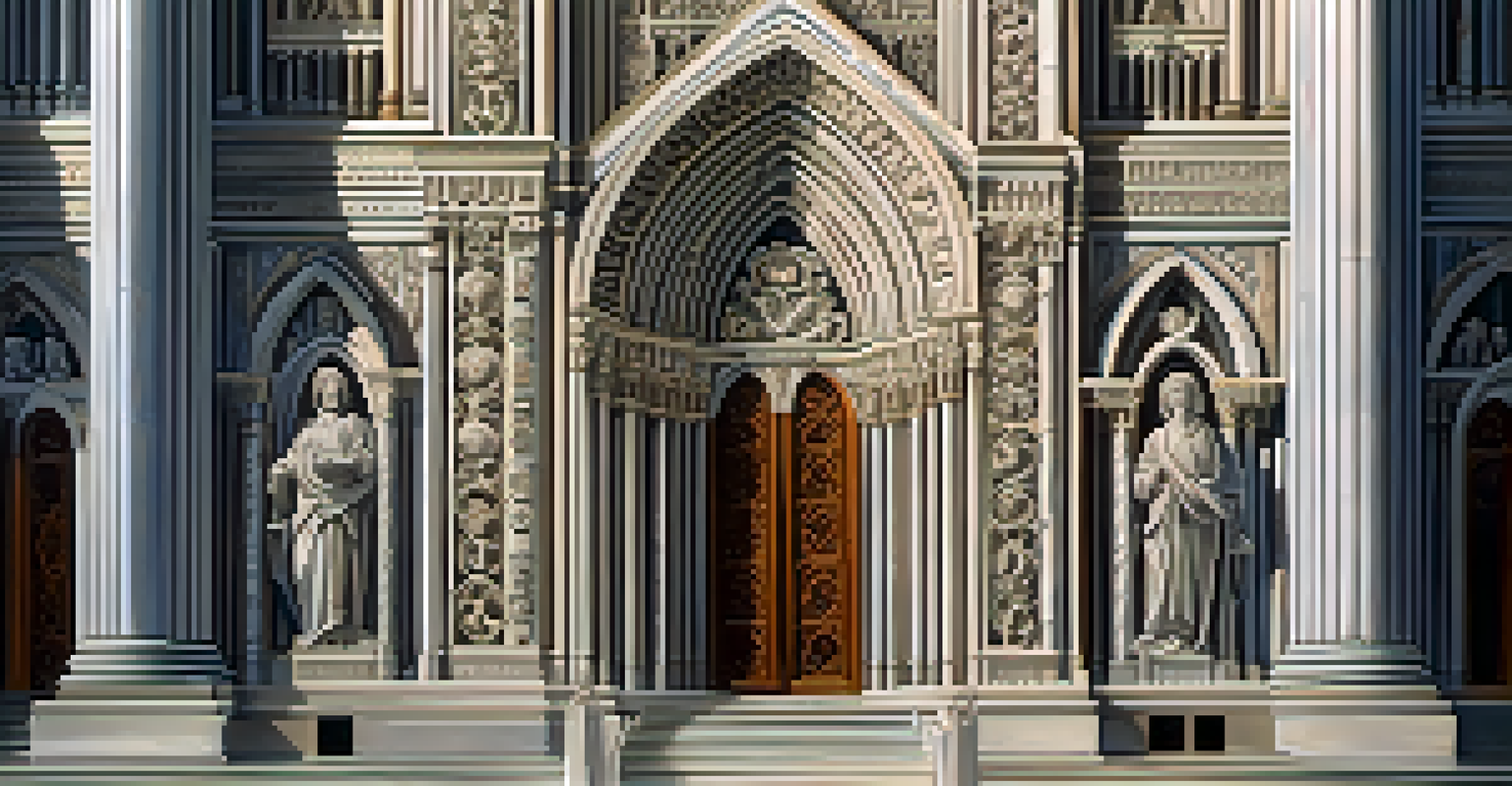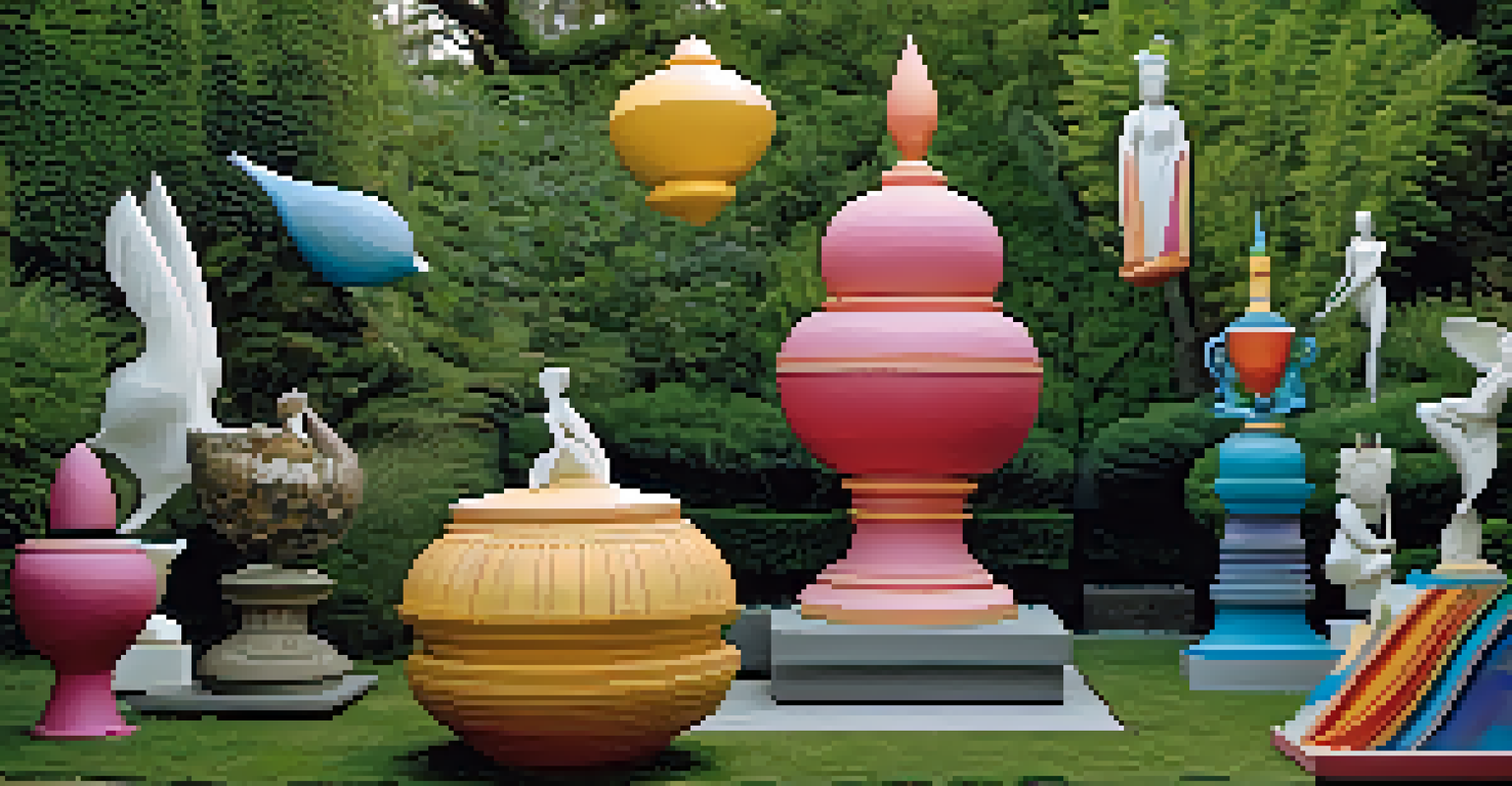Comparative Analysis of Carving in Eastern vs Western Religions

Understanding Carving in Religious Contexts
Carving holds a deep significance in many religions, serving as a means of expression and communication of beliefs. In both Eastern and Western contexts, carving can be seen as a way to connect with the divine or represent sacred stories. The act of carving transforms raw materials into symbols that embody spiritual concepts, reflecting the culture and values of the people who create them.
Art is the most beautiful of all lies.
In the East, carving often involves intricate designs that convey philosophical ideas, such as the cycle of life and the concept of enlightenment. In contrast, Western carving frequently emphasizes narratives from religious texts, illustrating key moments in the faith's history. Both approaches highlight the importance of storytelling and symbolism in religious practices.
Ultimately, the practice of carving serves as a bridge between the physical and spiritual worlds, allowing practitioners to manifest their beliefs in a tangible form. This connection is crucial for understanding how different cultures express their spirituality through art.
Materials and Techniques in Eastern Carving
Eastern religious carvings often utilize materials such as wood, stone, and ivory, each chosen for their symbolic meanings and durability. For instance, in Buddhist cultures, wood is commonly used for statues of the Buddha, reflecting simplicity and the impermanence of material possessions. The techniques involved can range from hand-carving to intricate reliefs, showcasing the artisans' skills and dedication.

The craftsmanship in Eastern carving is often detailed and ornate, with layers of meaning embedded in each design. For example, lotus flowers in Hindu carvings symbolize purity and spiritual awakening, while dragons in Chinese art represent power and good fortune. These carefully crafted pieces serve as reminders of the values and teachings central to these faiths.
Carving as Spiritual Expression
Carving serves as a powerful means of expressing and communicating spiritual beliefs across various cultures.
Moreover, the process of creating these carvings is often meditative, allowing artisans to enter a state of mindfulness. This connection between the maker and the material fosters a deeper spiritual engagement, resulting in works that are not only beautiful but also imbued with meaning.
Materials and Techniques in Western Carving
In Western religions, carving materials commonly include marble, wood, and bronze, with each chosen for its aesthetic and historical significance. For instance, marble is often associated with classical sculptures in Christianity, representing purity and permanence. The techniques here can vary from chiseling to casting, reflecting both the skill of the artist and the cultural context.
Every act of creation is first an act of destruction.
Western carvings frequently depict biblical scenes and figures, serving to educate and inspire the faithful. A prime example is the intricate carvings on cathedrals that narrate stories from the Bible, allowing passersby to engage with their faith visually. These carvings not only enhance the architectural beauty but also serve a didactic purpose.
Additionally, the symbolism in Western carvings often revolves around key themes such as redemption, sacrifice, and the divine. By capturing these pivotal moments in tangible forms, artists create a dialogue between the viewer and the artwork, inviting contemplation and reflection on one's spirituality.
Symbolism in Eastern Religious Carvings
Symbolism is at the heart of Eastern religious carvings, where each element carries profound meaning. For instance, the depiction of Kwan Yin, the Bodhisattva of compassion in Buddhism, reflects the importance of mercy and kindness. These symbols are not just decorative; they serve as reminders of the virtues that followers strive to embody in their lives.
Common symbols include the mandala, which represents the universe and spiritual journey, and the yin-yang symbol, embodying balance and harmony. Such carvings often serve as focal points in meditation practices, guiding practitioners toward deeper understanding and enlightenment. The intricate designs encourage viewers to contemplate their place in the universe.
Symbolism in Religious Art
Both Eastern and Western carvings utilize rich symbolism to convey profound theological concepts and moral lessons.
By integrating these symbols into their art, Eastern artisans create pieces that resonate on multiple levels—visually, emotionally, and spiritually. This deep connection enhances the viewer's experience and fosters a greater appreciation for the teachings of their faith.
Symbolism in Western Religious Carvings
In Western religious carvings, symbolism plays a crucial role in conveying theological concepts and moral lessons. For example, the cross in Christian art symbolizes sacrifice and redemption, central themes in the faith. Carvings often depict saints and angels, serving as reminders of divine presence and guidance in daily life.
Another powerful symbol is the lamb, representing Jesus as the 'Lamb of God' and embodying innocence and sacrifice. These symbols are intricately woven into the fabric of Western religious art, allowing believers to engage with their faith visually and emotionally. The narratives told through these carvings help to reinforce core beliefs and values.
Furthermore, the use of light and shadow in Western carvings can create a sense of drama and highlight the spiritual significance of the scenes depicted. This technique not only enhances the aesthetic appeal but also invites contemplation and deeper understanding of the messages conveyed through the artwork.
Cultural Influences on Carving Practices
Cultural influences significantly shape carving practices in both Eastern and Western religions. In Eastern traditions, the philosophies of Buddhism, Hinduism, and Taoism deeply inform the themes and techniques used in carving. For instance, the influence of Zen Buddhism is evident in the simplicity and elegance of certain carvings, emphasizing mindfulness and the beauty of imperfection.
Conversely, Western carving practices have been influenced by historical movements such as the Renaissance, which emphasized realism and humanism. This shift allowed artists to explore more complex themes and emotional expressions in their work. The interplay of cultural and religious narratives creates a rich tapestry of meaning behind each carving.
Modern Adaptations of Carving
Contemporary carving integrates traditional techniques with modern themes, ensuring the relevance of religious practices for new generations.
Moreover, the exchange of ideas between cultures has led to a blending of styles and techniques, resulting in unique interpretations of religious themes. This cross-pollination enriches the artistic landscape, allowing for a more diverse understanding of spirituality through carving.
The Role of Carving in Contemporary Religious Practices
In contemporary times, carving continues to play a vital role in religious practices, acting as a bridge between tradition and modernity. Many artisans are now incorporating contemporary themes into traditional carving techniques, allowing for a fresh interpretation of age-old beliefs. This evolution helps to keep religious practices relevant and engaging for newer generations.
For instance, modern sculptures may blend traditional motifs with abstract forms, inviting viewers to explore spirituality in new ways. This adaptability reflects the dynamic nature of faith, where ancient practices can find new life in contemporary contexts. The result is a dialogue between past and present that enriches the spiritual experience.

Additionally, the rise of digital technology has opened new avenues for carving, with artists using 3D modeling and CNC machines alongside traditional hand-carving. This fusion of old and new techniques allows for greater creativity and innovation, ensuring that carving remains a vital expression of faith in the modern world.